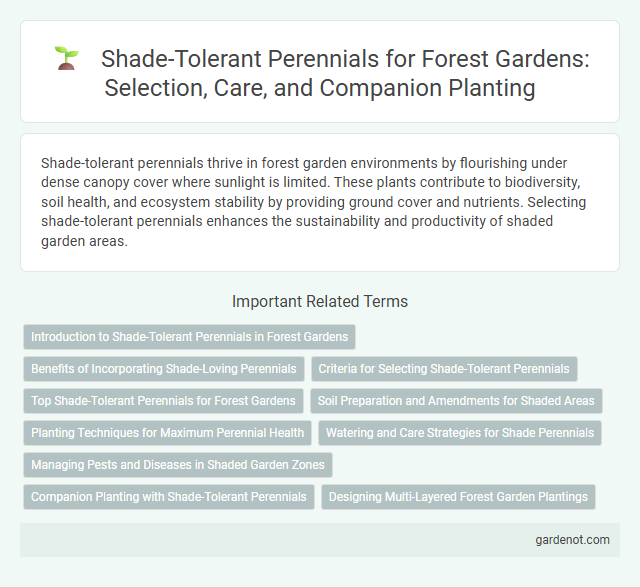Shade-tolerant perennials thrive in forest garden environments by flourishing under dense canopy cover where sunlight is limited. These plants contribute to biodiversity, soil health, and ecosystem stability by providing ground cover and nutrients. Selecting shade-tolerant perennials enhances the sustainability and productivity of shaded garden areas.
Introduction to Shade-Tolerant Perennials in Forest Gardens
Shade-tolerant perennials are essential components of forest gardens, thriving under the canopy where sunlight is limited. These plants, such as hostas, ferns, and Solomon's seal, provide ground cover, improve soil health, and support biodiversity by attracting pollinators and beneficial insects. Their ability to flourish in low-light conditions ensures year-round productivity and ecological balance within forest garden ecosystems.
Benefits of Incorporating Shade-Loving Perennials
Incorporating shade-loving perennials like hostas and ferns enhances forest garden biodiversity by filling understory niches where sunlight is limited. These plants improve soil quality through organic matter accumulation and foster a microhabitat that supports beneficial insects and pollinators. Their low maintenance requirements and resilience to fluctuating light conditions make them ideal for sustainable, layered garden designs.
Criteria for Selecting Shade-Tolerant Perennials
Selecting shade-tolerant perennials for a forest garden requires evaluating their light requirements, ensuring they thrive in low to moderate shade conditions under the tree canopy. Consider plants with deep root systems and slow growth rates that minimize competition for nutrients and water in shaded, forest floor environments. Prioritize native species and those known for shade adaptation, such as hostas, ferns, and Solomon's seal, which contribute to biodiversity and ecosystem stability within the garden.
Top Shade-Tolerant Perennials for Forest Gardens
Top shade-tolerant perennials for forest gardens include hostas, ferns, and astilbes, which thrive under low-light conditions while enhancing biodiversity. These plants improve soil health through deep root systems that prevent erosion and facilitate nutrient cycling. Incorporating shade-tolerant perennials maximizes space efficiency and creates a layered ecosystem that supports pollinators and soil microorganisms.
Soil Preparation and Amendments for Shaded Areas
Shade-tolerant perennials thrive in forest garden systems when soil preparation emphasizes organic matter enrichment and moisture retention. Incorporating well-rotted compost, leaf mold, and bark mulch enhances soil structure and nutrient availability in shaded areas. Adjusting pH with lime or sulfur and ensuring adequate mycorrhizal fungi supports root health and maximizes growth under limited sunlight.
Planting Techniques for Maximum Perennial Health
Shade-tolerant perennials thrive in low-light forest garden environments by benefiting from strategic planting techniques such as amended soil with organic matter and mulching to retain moisture and regulate temperature. Establishing these plants in partial shade zones beneath taller canopy layers mimics their natural habitats and enhances root development and nutrient uptake. Regular monitoring for soil compaction and maintaining proper spacing prevents competition and promotes robust perennial health.
Watering and Care Strategies for Shade Perennials
Shade-tolerant perennials in a forest garden require consistent watering strategies that focus on maintaining moist, well-drained soil to support root health and prevent fungal diseases. Mulching with organic materials like leaf litter or wood chips helps retain soil moisture and regulate temperature, enhancing plant resilience under shady conditions. Regular monitoring for pests and ensuring adequate airflow are essential components of care, promoting vigorous growth and long-term sustainability of shade-adapted perennials.
Managing Pests and Diseases in Shaded Garden Zones
Shade-tolerant perennials in forest gardens require targeted pest and disease management strategies that accommodate low-light conditions and high humidity. Employing natural predators, such as ladybugs and predatory mites, alongside organic treatments like neem oil helps suppress common pests like aphids and spider mites without disrupting the delicate ecosystem. Regular monitoring and maintaining plant diversity improve resilience, reducing outbreaks and promoting healthy growth in shaded garden zones.
Companion Planting with Shade-Tolerant Perennials
Shade-tolerant perennials like hostas, ferns, and astilbes thrive in forest garden understories, providing ground cover and preventing soil erosion. These plants improve biodiversity by supporting beneficial insects and enhancing soil health through their deep root systems. Companion planting with shade-tolerant perennials creates microclimates that protect young trees and promote resilient forest garden ecosystems.
Designing Multi-Layered Forest Garden Plantings
Shade-tolerant perennials such as hostas, ferns, and Solomon's seal thrive in the understory of multi-layered forest gardens, contributing to biodiversity and soil health. Incorporating these plants beneath taller canopy trees and shrubs maximizes vertical space and creates a self-sustaining ecosystem with varied microclimates. Careful selection of shade-tolerant species ensures continuous ground cover, reduces weed growth, and supports beneficial insects and soil microorganisms essential for forest garden resilience.
Shade-tolerant perennial Infographic

 gardenot.com
gardenot.com